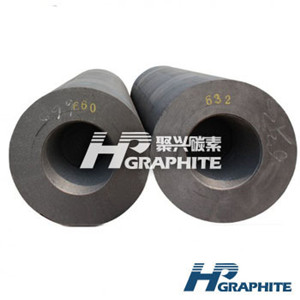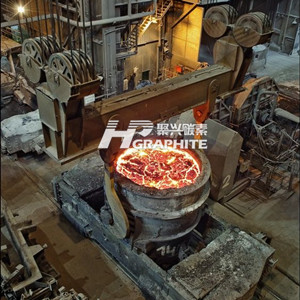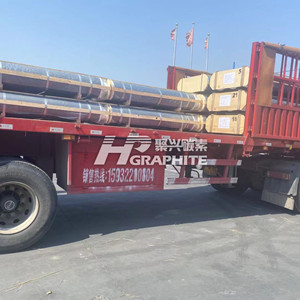Graphite electrode: Steel market upstream core materials and industry leaders comprehensive review

Graphite electrode: Steel market upstream core materials and industry leaders comprehensive review
According to the steel industry adjustment policy issued by Ministry of Industry and Information Technology (MIIT), it is clearly proposed to "encourage the promotion of the application of short-process steelmaking processes and equipment with scrap steel as raw material". By 2025, the steel-making scrap rate of Chinese steel enterprises will not be less than 30%.
With the formulation of the "14th Five-Year plan" in various fields, the increasing proportion of short processes is expected to further increase the demand for graphite electrodes, a key upstream material.
At the same time, China's policy support and guidance for EAF short process steelmaking to replace converter steelmaking has promoted the demand for China's steel industry graphite electrodes.
According to the data, in 2018, the maximum capacity utilization rate of the graphite electrode industry reached 61.68%, and has continued to fall since then. The capacity utilization rate in 2021 was 53%. Graphite electrode industry capacity is mainly distributed in North China and Northeast China. In 2021, the graphite electrode capacity in North China and Northeast China accounted for more than 60%. From 2017 to 2021, the capacity of "2+26" cities' graphite electrode was stable at 400,000-460,000 tons.
As graphite electrode price falls and tends to be stable, the demand for China's EAF steelmaking graphite electrode has increased steadily, and the export volume of UHP (ultra-high power) graphite electrode has gradually increased. The market concentration of China's graphite electrode industry will rise steadily and the industry will gradually mature.

1. Graphite electrode industry overview
Graphite electrode is a conductive material mainly used in iron and steel smelting. It is a non-metallic solid material dominated by carbon. It is made of petroleum coke and needle coke as raw materials and coal tar pitch as binder. It is a conductor that releases electric energy in the form of electric arc in the EAFs to heat and melt the furnace charge after calcining, batching, kneading, molding, baking, graphitization and machining.
According to the quality index, it can be divided into regular power (RP) graphite electrode, high power (HP) graphite electrode and ultra-high power (UHP) graphite electrode. The main difference is the ability of carrying current density, which is suitable for different power arc furnaces.
The production process of graphite electrode is long and complex. There are certain barriers in the process and equipment. Baking and impregnation are the core processes.
At present, the production of UHP graphite electrodes at home and abroad mainly adopts the "one time impregnation and two times baking" process, which belongs to the mature experience of advanced carbon enterprises at home and abroad for many years, the process is complex, and in order to ensure product quality, the automatic control system must be used to control and manage the production process. The nipples require "three times impregnation and four times baking".
Baking production cycle is long and energy consumption is high, which also has a great impact on the quality of finished products and the yield of subsequent processes. Therefore, the selection of baking furnace is very important.
In addition, the process needs to be matched with foreign advanced equipment, for instance, the fully automatic batching vertical tamping horizontal press and other equipment to achieve large-scale production. New enterprises need to spend a lot of time and money on research and development to master the process and support the corresponding equipment.

2. Graphite electrode industry chain
The upstream raw materials of the graphite electrode industry chain are mainly petroleum coke and needle coke, which account for a large proportion of the production cost of graphite electrode, accounting for more than 65%.
Due to the large gap between China's needle coke production process and technology and the United States, Japan and other countries, the quality of domestic needle coke is difficult to guarantee, so China's dependence on imported high-quality needle coke is still high.
The main downstream application of graphite electrode is EAF steelmaking.
EAF steelmaking is the largest downstream demand for graphite electrodes, accounting for 80% at home and 90% abroad.
UHP graphite electrode can be used in large capacity EAF and special steel EAF.
The first feature of graphite electrode is that it can conduct current and generate electricity, so as to produce high-temperature molten scrap iron or other raw materials in blast furnace to produce steel and other metal products; The second feature is low resistivity and resistance to thermal gradient in EAF, so it is widely used in iron and steel industry.
In terms of demand, the increase of EAFs' proportion has promoted graphite electrodes consumption, while the supply side is constrained by the reduced elasticity of capacity release, which will promote the future demand of graphite electrodes for EAF steelmaking.

3. Graphite electrode market pattern
The supply elasticity of graphite electrode is weak, which is easy to cause the mismatch between supply and demand.
As graphite electrode is a high-energy consumption industry, in China, the start up situation of existing enterprises in the industry is controlled, and staggered peak production is implemented. Enterprises with low energy consumption can obtain higher operating time. In recent years, the operating rate of the industry has basically fluctuated around 50%.
Graphite electrode production process is long, and the cost accounts for less than 2.5% in the downstream. The small supply elasticity is easy to cause the price to soar. At present, two factors restrict the supply elasticity of the graphite electrode industry:
At present, under the background of higher requirements for environmental protection and energy consumption and more technical support for high-end products, small and medium-sized enterprises are facing greater pressure and their overall capacity utilization rate is low. The capacity utilization rate of some enterprises (840,000 tons in 2021) has been lower than 30% for a long time.
Graphite electrode belongs to the "two high" project. During the "14th Five-year plan" period, the production of enterprises with low capacity utilization and investment in new capacity in the industry are expected to be further restricted. In the future, the difficulty of capacity investment in the carbon industry will increase, which is expected to improve the concentration of leading enterprises and reshape the industrial supply pattern without new capacity.
Since 2017, the capacity utilization rate of top3 leading enterprises and second tier enterprises is much higher than the industry average, while the capacity utilization rate of other enterprises is low, between 20% and 40%.
In 2020, the capacity utilization rate of the top3 enterprises was 64% (mainly caused by the production of some new capacity), the capacity utilization rate of the second tier enterprises was 74%, and the capacity utilization rate of the rest enterprises was only 23%, indicating that the polarization of capacity utilization rate of enterprises in the graphite electrode industry is obvious.
Statistics show that China's new and expanded graphite electrode production capacity will increase by about 250,000 tons in 2022. With the stricter approval of new projects in China, it is expected that the capacity release rate will further slow down after 2022.
The guiding opinions on the "14th Five-Year plan" development plan and long-term goals of China's carbon industry pointed out that "Without increasing domestic production capacity, promote and encourage large backbone enterprises to participate in, control, merge or acquire other carbon enterprises". During the "14th Five-Year plan" period, the concentration of carbon industry is expected to increase significantly.
Affected by the current national energy consumption double control policy, on energy consumption, the graphite electrode industry, as a high-energy consumption industry, its new capacity will be strictly controlled. On February 25, 2021, the Inner Mongolia Development and Reform Commission issued the "several safeguard measures on ensuring the completion of the "14th Five-Year Plan" energy consumption double control goals (Draft for Comments), proposing that from 2021, no more approval will be given to the new capacity projects of graphite electrodes below UHP. High policy barriers and environmental barriers make it difficult for new enterprises to enter the graphite electrode industry. Follow us to read more reports of graphite electrode industry.
No related results found








0 Replies